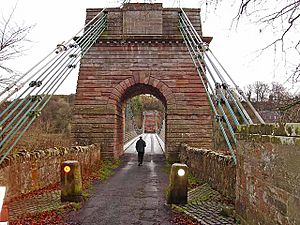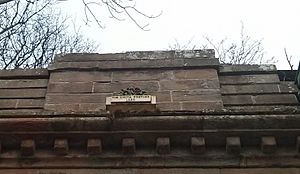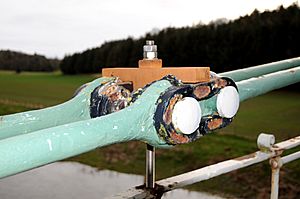Union Chain Bridge facts for kids
Quick facts for kids Union Bridge |
|
|---|---|

The bridge from the north on the Scottish bank
|
|
| Coordinates | 55°45′09″N 2°06′25″W / 55.7525°N 2.107°W |
| Crosses | River Tweed |
| Characteristics | |
| Material | wrought iron (original) sandstone ashlar steel (modern upgrade) |
| Number of spans | 1 |
| Design life | 1871: bridge deck replaced 1902: additional cables added 1974: bridge refurbished 2020:complete restoration |
| History | |
| Designer | Captain Samuel Brown |
| Construction begin | 1819 |
| Opened | 26 July 1820 |
The Union Chain Bridge is a special kind of bridge called a suspension bridge. It stretches across the River Tweed, connecting Horncliffe in England with Fishwick in Scotland. This bridge is about 4 miles (6.4 km) upstream from Berwick-upon-Tweed.
When it first opened in 1820, it was a huge deal! It was the longest bridge in the world made of wrought iron (a strong type of iron). It was also the very first bridge of its kind in the United Kingdom that cars and wagons could drive over. Even though another famous bridge, the Menai Suspension Bridge, started being built earlier, the Union Bridge was finished first.
Today, the Union Chain Bridge is the oldest suspension bridge in the world that still carries road traffic. It's recognized as an important historical site in both Scotland and England. It's also part of popular cycling routes like Sustrans Route 1.
Contents
How the Bridge Was Built
Before this bridge existed, crossing the River Tweed in this area was tricky. People had to travel about 11 miles (18 km) downstream to Berwick or 20 miles (32 km) upstream to Coldstream. Sometimes, people would cross the river by wading through it, but this was impossible when the water was high. To make things easier, a group called the Berwick and North Durham Turnpike Trust decided a new bridge was needed.
Who Designed the Union Bridge?
The bridge was designed by Captain Samuel Brown, an officer in the English Royal Navy. Captain Brown was very clever. He noticed that the hemp ropes used on ships often broke, causing problems. So, he started working with blacksmiths to create stronger chains made of wrought iron.
In 1806, one of his ships, HMS Penelope, was fitted with these new iron chains. They worked so well that in 1808, he started a company to make them. After leaving the Navy in 1812, he built a small test bridge in 1813. It was 105 feet (32 meters) long and strong enough to hold a carriage! Famous engineers like John Rennie and Thomas Telford were impressed.
Captain Brown received patents for his chain-making methods and for building bridges with these chains. He even suggested building a much longer bridge (1,000 feet or 300 meters) over the River Mersey, but that one was never built. We don't know exactly why he got involved with the Union Bridge, but he agreed to design it in 1818.
Building the Bridge

Captain Brown was an expert in iron chains, but he wasn't a masonry expert (building with stone). So, John Rennie helped with the stone parts of the bridge.
Permission to build the bridge was given in July 1819, and construction began very quickly on August 2, 1819.
The bridge has one main span that is 449 feet (137 meters) long. On the Scottish side, there's a strong stone tower. On the English side, the bridge's chains are supported by a stone tower built right into the steep riverbank. This is why the road on the Scottish side goes straight to the bridge, but on the English side, it has to turn sharply.
The Union Chain Bridge officially opened on July 26, 1820. Many important people attended the opening, including the Scottish engineer Robert Stevenson. Captain Brown himself tested the bridge by driving a carriage pulling twelve carts across it! About 700 people watched this amazing event.
For many years, people had to pay a toll (a fee) to cross the bridge. The small house where tolls were collected on the English side was taken down in 1955.
How the Bridge Has Been Used and Cared For
After 1885, when tolls were no longer collected, the responsibility for keeping the bridge in good shape went to different local councils. Today, Northumberland County Council takes care of it.
Over the years, the bridge has been strengthened and repaired many times. In 1871, the bridge's deck (the part you drive on) was replaced. More cables were added in 1902, and the bridge was refurbished in 1974. The chains have also been reinforced regularly.
Keeping the Bridge Strong
The bridge has had to close a few times for safety. In 2007, it was closed to cars because one of its hangers (parts that hold the deck) broke. In 2008, a landslide caused another closure.
By 2013, there were worries that the bridge might have to close permanently because there wasn't enough money to fix it. It was even put on a list of historical sites at risk. But in October 2014, local people started a campaign to get the bridge fully restored in time for its 200th birthday in 2020.
In 2017, the local councils agreed to put money towards a big restoration project. More money was pledged by other groups, including the National Lottery Heritage Fund. The major restoration work began in October 2020 and cost about £10.5 million. The old chains were carefully cut in March 2021, and the restored bridge finally reopened on April 17, 2023. Soon after, it was named a Historic Civil Engineering Landmark by a major engineering group in the United States.




